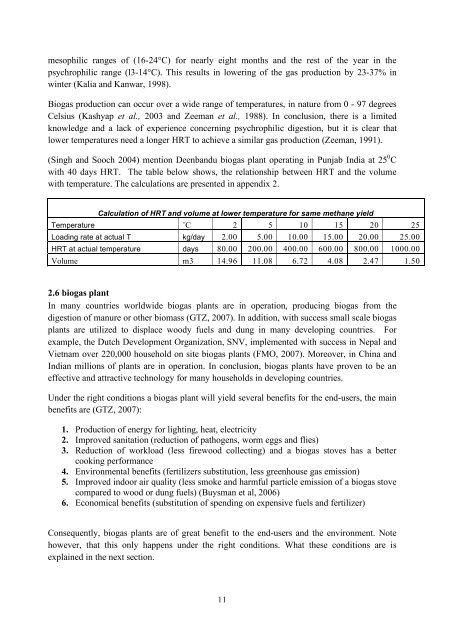Biogas production in climates with long cold winters - SuSanA
Biogas production in climates with long cold winters - SuSanA
Biogas production in climates with long cold winters - SuSanA
You also want an ePaper? Increase the reach of your titles
YUMPU automatically turns print PDFs into web optimized ePapers that Google loves.
mesophilic ranges of (16-24°C) for nearly eight months and the rest of the year <strong>in</strong> the<br />
psychrophilic range (l3-14°C). This results <strong>in</strong> lower<strong>in</strong>g of the gas <strong>production</strong> by 23-37% <strong>in</strong><br />
w<strong>in</strong>ter (Kalia and Kanwar, 1998).<br />
<strong>Biogas</strong> <strong>production</strong> can occur over a wide range of temperatures, <strong>in</strong> nature from 0 - 97 degrees<br />
Celsius (Kashyap et al., 2003 and Zeeman et al., 1988). In conclusion, there is a limited<br />
knowledge and a lack of experience concern<strong>in</strong>g psychrophilic digestion, but it is clear that<br />
lower temperatures need a <strong>long</strong>er HRT to achieve a similar gas <strong>production</strong> (Zeeman, 1991).<br />
(S<strong>in</strong>gh and Sooch 2004) mention Deenbandu biogas plant operat<strong>in</strong>g <strong>in</strong> Punjab India at 25 0 C<br />
<strong>with</strong> 40 days HRT. The table below shows, the relationship between HRT and the volume<br />
<strong>with</strong> temperature. The calculations are presented <strong>in</strong> appendix 2.<br />
Calculation of HRT and volume at lower temperature for same methane yield<br />
Temperature ˚C 2 5 10 15 20 25<br />
Load<strong>in</strong>g rate at actual T kg/day 2.00 5.00 10.00 15.00 20.00 25.00<br />
HRT at actual temperature days 80.00 200.00 400.00 600.00 800.00 1000.00<br />
Volume m3 14.96 11.08 6.72 4.08 2.47 1.50<br />
2.6 biogas plant<br />
In many countries worldwide biogas plants are <strong>in</strong> operation, produc<strong>in</strong>g biogas from the<br />
digestion of manure or other biomass (GTZ, 2007). In addition, <strong>with</strong> success small scale biogas<br />
plants are utilized to displace woody fuels and dung <strong>in</strong> many develop<strong>in</strong>g countries. For<br />
example, the Dutch Development Organization, SNV, implemented <strong>with</strong> success <strong>in</strong> Nepal and<br />
Vietnam over 220,000 household on site biogas plants (FMO, 2007). Moreover, <strong>in</strong> Ch<strong>in</strong>a and<br />
Indian millions of plants are <strong>in</strong> operation. In conclusion, biogas plants have proven to be an<br />
effective and attractive technology for many households <strong>in</strong> develop<strong>in</strong>g countries.<br />
Under the right conditions a biogas plant will yield several benefits for the end-users, the ma<strong>in</strong><br />
benefits are (GTZ, 2007):<br />
1. Production of energy for light<strong>in</strong>g, heat, electricity<br />
2. Improved sanitation (reduction of pathogens, worm eggs and flies)<br />
3. Reduction of workload (less firewood collect<strong>in</strong>g) and a biogas stoves has a better<br />
cook<strong>in</strong>g performance<br />
4. Environmental benefits (fertilizers substitution, less greenhouse gas emission)<br />
5. Improved <strong>in</strong>door air quality (less smoke and harmful particle emission of a biogas stove<br />
compared to wood or dung fuels) (Buysman et al, 2006)<br />
6. Economical benefits (substitution of spend<strong>in</strong>g on expensive fuels and fertilizer)<br />
Consequently, biogas plants are of great benefit to the end-users and the environment. Note<br />
however, that this only happens under the right conditions. What these conditions are is<br />
expla<strong>in</strong>ed <strong>in</strong> the next section.<br />
11
















